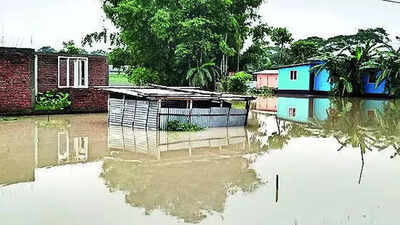- News
- City News
- guwahati News
- Bhutan's rainfall warning puts Assam on alert, over 34,000 affected by floods in state
Trending
Bhutan's rainfall warning puts Assam on alert, over 34,000 affected by floods in state

GUWAHATI: The Royal Government of Bhutan's weather advisory on Tuesday warning more rainfall in isolated areas of Bhutan in the next couple of days may lead to rising water levels in the Brahmaputra and its tributaries in Assam.
This has compelled the Assam State Disaster Management Authority (ASDMA) to ask Assam residents to be on alert even as the flood situation worsened in the state in the last 24 hours.
Over 3,000 more people have been hit by the first wave of floods, taking the number of flood-affected population in the state to 34,089 as on Tuesday evening. This includes the population in all four districts of the state - Kokrajhar, Chirang, Baksa and Udalguri - which shares a boundary with Bhutan. The number of flood-affected districts and sub-divisions in Assam has also gone up to 19 from 18.
The Royal Government of Bhutan's weather advisory said cloudy weather with light to moderate rainfall may occur in isolated areas of Bhutan in the next 2-3 days, following which ASDMA advised all residents living in the riverine areas of Assam to be prepared with emergency kits and avoid venturing into rising waters during this period. "Further, people are urged to refrain from activities such as fishing, collecting firewood, swimming or crossing rivers unnecessarily during these days," the ASDMA cautioned.
Menwhile, athe IMD issued a red alert of heavy to very heavy rainfall with extremely heavy rainfall at isolated places as very likely over Kokrajhar, Chirang, Baksa, Barpeta and Bongaion districts till Wednesday morning.
Nine rivers in the state are flowing above normal, according to the Central Water Commission (CWC) report. Puthimari river is extremely flooded, while Pagladiya and Sankosh, all in western Assam, are severely flooded.
The most number of people affected - 22,061 - is in Lakhimpur district, while 3,857 are affected in Dibrugarh. A total of 5842.78 hectares of crop area have been affected. The number of relief camps remained static at 25, of which 14 have been operational in Lakhimpur.
This has compelled the Assam State Disaster Management Authority (ASDMA) to ask Assam residents to be on alert even as the flood situation worsened in the state in the last 24 hours.
Over 3,000 more people have been hit by the first wave of floods, taking the number of flood-affected population in the state to 34,089 as on Tuesday evening. This includes the population in all four districts of the state - Kokrajhar, Chirang, Baksa and Udalguri - which shares a boundary with Bhutan. The number of flood-affected districts and sub-divisions in Assam has also gone up to 19 from 18.
The Royal Government of Bhutan's weather advisory said cloudy weather with light to moderate rainfall may occur in isolated areas of Bhutan in the next 2-3 days, following which ASDMA advised all residents living in the riverine areas of Assam to be prepared with emergency kits and avoid venturing into rising waters during this period. "Further, people are urged to refrain from activities such as fishing, collecting firewood, swimming or crossing rivers unnecessarily during these days," the ASDMA cautioned.
Linking rising water levels and floods with the release of water from the Kurichhu Dam in Bhutan has caused panic among the population of western Assam districts. The ASDMA, however, said the flood situation in western Assam is not solely caused by the water release from the dam but is also a result of continuous rainfall in the upper catchment areas of both Bhutan and Assam.
Menwhile, athe IMD issued a red alert of heavy to very heavy rainfall with extremely heavy rainfall at isolated places as very likely over Kokrajhar, Chirang, Baksa, Barpeta and Bongaion districts till Wednesday morning.
Nine rivers in the state are flowing above normal, according to the Central Water Commission (CWC) report. Puthimari river is extremely flooded, while Pagladiya and Sankosh, all in western Assam, are severely flooded.
The most number of people affected - 22,061 - is in Lakhimpur district, while 3,857 are affected in Dibrugarh. A total of 5842.78 hectares of crop area have been affected. The number of relief camps remained static at 25, of which 14 have been operational in Lakhimpur.

About the Author
Kangkan KalitaKangkan Kalita is a reporter with The Times of India and covers issues on health, education, stories of human interest while keeping a close watch on political developments and student movements. Reporting on environment and forest related issues and concerns of the northeast interest him equally.
Start a Conversation
FOLLOW US ON SOCIAL MEDIA
FacebookTwitterInstagramKOO APPYOUTUBE










